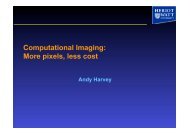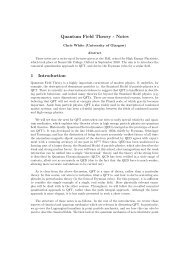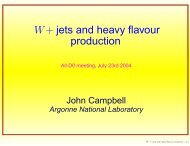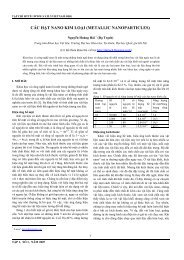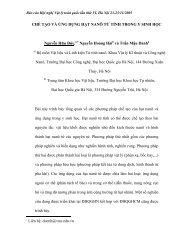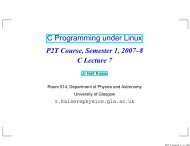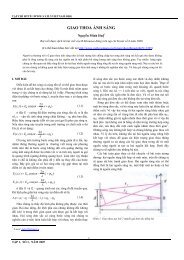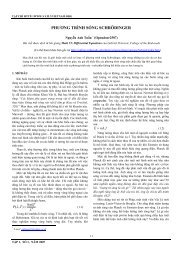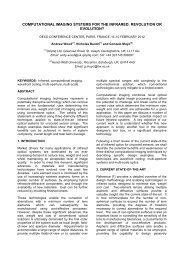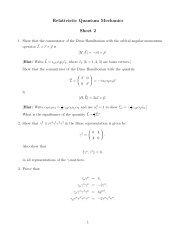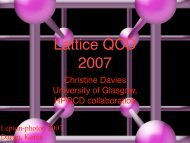Nuclear physics and technology – inside the atom
Nuclear physics and technology – inside the atom
Nuclear physics and technology – inside the atom
- No tags were found...
Create successful ePaper yourself
Turn your PDF publications into a flip-book with our unique Google optimized e-Paper software.
Contents346810121415ForewordIntroductionThe complex heart of matterScienceExploring <strong>the</strong> nucleusApplications <strong>–</strong> Health<strong>Nuclear</strong> medicineApplications <strong>–</strong> EnergyHarnessing <strong>the</strong> nucleus for powerApplications <strong>–</strong> Industry, environment <strong>and</strong> societyA powerful analytical toolTechnology transfer <strong>and</strong> trainingNew technologiesEducation in nuclear science2
<strong>Nuclear</strong> <strong>physics</strong> <strong>and</strong> <strong>technology</strong> <strong>–</strong> <strong>inside</strong> <strong>the</strong> <strong>atom</strong>ForewordThe uncovering of <strong>the</strong> structure of <strong>atom</strong>s <strong>–</strong> <strong>the</strong> basic units of matter <strong>–</strong> as composed of clouds of electrons surroundinga central nucleus is one of <strong>the</strong> l<strong>and</strong>mark 20th-century discoveries, underpinning modern healthcare, advanced materials<strong>and</strong> information <strong>technology</strong>. However, while <strong>the</strong> chemical <strong>and</strong> physical characteristics of <strong>atom</strong>ic electrons have beenstudied thoroughly, <strong>and</strong> have been successfully exploited to make pharmaceuticals, plastics <strong>and</strong> electronic devices, forexample, <strong>the</strong> nucleus is less well understood.The forces binding toge<strong>the</strong>r <strong>the</strong> components of <strong>the</strong> nucleus are extremely strong, <strong>and</strong> so require <strong>the</strong> input of highenergies, using large accelerator facilities, to probe <strong>and</strong> manipulate <strong>the</strong>ir structure <strong>and</strong> behaviour. Fur<strong>the</strong>rmore, <strong>the</strong>strong interactions involved are extremely complex <strong>and</strong> difficult to unravel both <strong>the</strong>oretically <strong>and</strong> experimentally.The importance of nuclear <strong>physics</strong> <strong>and</strong> <strong>technology</strong>Over <strong>the</strong> past decades, studies of <strong>the</strong> nucleus have led to many major developments that have transformed our lives. Oneof <strong>the</strong> most significant has been in medicine: in developing nuclear methods to treat cancer safely, to analyse biologicalprocesses <strong>and</strong> diagnose disease using medical isotopes, <strong>and</strong> to image <strong>the</strong> body non-invasively. The application of nuclearbasedanalytical techniques continues to revolutionise <strong>the</strong> chemical <strong>and</strong> life sciences, <strong>and</strong> plays an increasing role inmonitoring environmental change, as well as providing new portable devices used to aid national security.A prominent application of nuclear research is in developing <strong>the</strong> long-term means of securing our energy needs within alow-carbon economy. Tapping into <strong>the</strong> powerful forces within <strong>the</strong> nucleus to generate power is a major goal of nuclear scientists<strong>and</strong> engineers. Revolutionary designs of fission reactors, some using novel fuel sources, are already being tested, while variousapproaches to nuclear fusion <strong>–</strong> <strong>the</strong> ideal environmentally-friendly solution to our energy needs <strong>–</strong> are being developed on aninternational scale. <strong>Nuclear</strong> transmutation is also being investigated as a means of destroying nuclear waste safely.Studies of <strong>the</strong> nucleus are also extending our underst<strong>and</strong>ing of <strong>the</strong> basic laws of nature <strong>and</strong> how <strong>the</strong> universe evolved.Much of nuclear <strong>physics</strong> research involves exploring <strong>the</strong> forces <strong>and</strong> particles characterising everyday matter, as well as moreexotic phenomena found in stars <strong>and</strong> <strong>the</strong> early universe. One of <strong>the</strong> most exciting areas of research is <strong>the</strong> investigation ofstellar processes by which all <strong>the</strong> elements are created, which involve unusual, unstable nuclear species. It is this kind ofresearch that attracts students into <strong>physics</strong>.This report describes <strong>the</strong> research carried out in nuclear <strong>physics</strong> <strong>and</strong> <strong>technology</strong>, <strong>and</strong> shows how <strong>the</strong> discoveries madeare leading to a growing range of applications in medicine, power generation, as well as environmental <strong>and</strong> security monitoring.Dr Robert Kirby-HarrisChief ExecutiveThe Institute of PhysicsThe UK roleThe <strong>atom</strong>ic nucleus was discoveredat <strong>the</strong> University of Manchester, <strong>and</strong>much of <strong>the</strong> early, seminal researchinto nuclear structure was carriedout in <strong>the</strong> UK. Today, vibrant nuclear<strong>physics</strong> research programmes continueacross Europe, including at exp<strong>and</strong>inginternational facilities in Germany <strong>and</strong>France. The EU recognises <strong>the</strong> economicimportance of <strong>the</strong>se centres through itssupport of <strong>the</strong> European Roadmap forResearch Infrastructures (ESFRI).<strong>Nuclear</strong> research in <strong>the</strong> UK is fundedprimarily by two members of <strong>the</strong> UKresearch councils family. The Engineering<strong>and</strong> Physical Sciences Research Council(EPSRC) funds nuclear engineering<strong>and</strong> also leads <strong>the</strong> UK Energy ResearchProgramme. The Science <strong>and</strong> TechnologyFacilities Council (STFC) funds nuclear<strong>physics</strong> <strong>and</strong> also manages facilities whichare used for a broad range of research,including some for nuclear <strong>physics</strong> <strong>and</strong>engineering challenges.3
<strong>Nuclear</strong> <strong>physics</strong> <strong>and</strong> <strong>technology</strong> <strong>–</strong> <strong>inside</strong> <strong>the</strong> <strong>atom</strong>The seminal work that led to <strong>the</strong>discovery of <strong>the</strong> <strong>atom</strong>ic nucleus wascarried out a century ago by <strong>the</strong> fa<strong>the</strong>rof nuclear <strong>physics</strong>, Ernest Ru<strong>the</strong>rford,at <strong>the</strong> University of Manchester.http://schools.medphys.ucl.ac.ukLung function can be assessed by breathing in agas containing radioisotopes of xenon or kryptonAn essential tool for society<strong>Nuclear</strong> research continues to lead to<strong>the</strong> development of new isotopes <strong>and</strong>methods that have become essentialanalytical tools in medicine, industry<strong>and</strong> environmental studies.The technical challenges<strong>Nuclear</strong> <strong>physics</strong> requires largescalesophisticated equipment <strong>–</strong>accelerators, large complex detectors<strong>and</strong> computer systems. Europeannuclear physicists, including <strong>the</strong> UKcommunity, have developed astrategy to provide transnationalaccess to a network of new nuclearresearch facilities.Future benefitsThe research carried out will providedeeper insights into <strong>the</strong> everydayworld, as well as <strong>the</strong> universe,while potentially furnishing <strong>the</strong>underpinning knowledge for future,economically invaluable <strong>and</strong> worldsavingtechnologies.A guide to<strong>the</strong> mighty <strong>atom</strong>•yAtoms consist of a positivelycharged nucleus with aconcentrated mass, surrounded bylightweight negative electrons.•yThe electrons are responsible for<strong>the</strong> chemical binding of <strong>atom</strong>s intomolecules, <strong>and</strong> for conducting electricity.•yNuclei consist of positively charged protons<strong>and</strong> neutral neutrons.•yToge<strong>the</strong>r, <strong>the</strong>y are responsible for <strong>the</strong> mass of <strong>the</strong> element.•yThe number of protons gives <strong>the</strong> element’s <strong>atom</strong>ic number.•yThe lightest element, hydrogen, has one proton in its nucleus; helium has twoprotons <strong>and</strong> usually two neutrons.•yThe heaviest naturally-occurring element, uranium, has 92 protons.•yElements can have varying numbers of neutrons, which are essential for stability,giving rise to isotopes with different masses.•ySome isotopes are unstable, spitting out alpha particles (helium nuclei),electrons (beta-radiation) or positrons (<strong>the</strong> positive, antimatter version ofelectrons), toge<strong>the</strong>r with high-energy electromagnetic radiation (gamma-rays).They are <strong>the</strong>n transmuted into o<strong>the</strong>r elements.•yMany radioactive isotopes exist naturally on Earth <strong>and</strong> in stars, but <strong>the</strong>y are alsomade in <strong>the</strong> laboratory.Even smaller• Protons <strong>and</strong> neutrons each consist of three fundamental particles called quarks.• They are combinations of <strong>the</strong> two lightest quarks; <strong>the</strong>re are also four, heavierquarks that form unstable nuclear particles.• Quarks can also bind in nuclear pairs calledmesons, some of which played a significantrole in <strong>the</strong> universe’s evolution.• Particles such as quarks <strong>and</strong>electrons also exist in antimatterforms with opposite charge.5
<strong>Nuclear</strong> <strong>physics</strong> <strong>and</strong> <strong>technology</strong> <strong>–</strong> <strong>inside</strong> <strong>the</strong> <strong>atom</strong>ExperimentsExperiments to underst<strong>and</strong> nucleirequire large-scale equipment thatcan accelerate to high energiesbeams of sub<strong>atom</strong>ic particles <strong>and</strong>charged ions (<strong>atom</strong>s stripped of mostof <strong>the</strong>ir electrons). These projectilenuclei are <strong>the</strong>n directed onto atarget. The principle is to make newnuclear species, ei<strong>the</strong>r by fusion of<strong>the</strong> projectile nuclei with those in <strong>the</strong>target, or by fragmenting <strong>the</strong> nuclei.The masses, lifetimes <strong>and</strong> energiesof <strong>the</strong> particles <strong>and</strong> <strong>the</strong> radiation(gamma-rays) emitted are measured.One aim is to make new magic nuclei<strong>and</strong> study <strong>the</strong>ir structure. Often, <strong>the</strong>nuclei are generated in high-energystates with unusual shapes, <strong>and</strong> maybe set spinning fast. The gamma-raysemitted, as <strong>the</strong> nuclei lose energy,provide information about nuclearstructure <strong>and</strong> behaviour. To underst<strong>and</strong><strong>the</strong> binding forces better, nuclei mayalso be prepared where <strong>the</strong> proportionsof protons <strong>and</strong> neutrons have beeninterchanged <strong>–</strong> to create ‘mirror’ nuclei.Additional experimental approachesinclude smashing toge<strong>the</strong>r beams ofheavy nuclei at high energies, with<strong>the</strong> aim of breaking <strong>the</strong>m up into <strong>the</strong>constituent quarks; high-energy lasers<strong>and</strong> electron beams are used to probe<strong>the</strong> structure of target nuclei; <strong>and</strong> veryhigh-energy lasers can induce nuclearreactions such as fission <strong>and</strong> fusion.Experiments have shown that <strong>the</strong> lead-186nucleus can adopt three different shapes at quitesimilar low energies. Physicists at <strong>the</strong> University ofLiverpool contributed to this seminal studyThe NuSTAR experiment at FAIR in Germany<strong>Nuclear</strong> <strong>physics</strong> in <strong>the</strong> UKThe existence of <strong>the</strong> <strong>atom</strong>ic nucleuswas uncovered in experiments at <strong>the</strong>University of Manchester a centuryago. Today, UK nuclear physicistscontinue <strong>the</strong>ir studies at facilitiesaround <strong>the</strong> world: in Europe, <strong>the</strong>US, Canada, Japan, South Africa<strong>and</strong> Australia. The core communityincludes groups from <strong>the</strong> Universitiesof Birmingham, Brighton, Edinburgh,Glasgow, Liverpool, Manchester,Surrey, <strong>the</strong> West of Scotl<strong>and</strong> <strong>and</strong>York, as well as <strong>the</strong> STFC DaresburyLaboratory in Cheshire. Theycollaborate in international teams todevelop new experimental set-ups, inparticular, dedicated devices such asdetectors (p14). Increasingly, nuclear<strong>physics</strong> <strong>and</strong> its applications arebecoming multidisciplinary, involvingastrophysicists, <strong>and</strong> <strong>atom</strong>ic, laser,The Exogam detector at <strong>the</strong> GANIL facilityin France where UK nuclear physicistsoften carry out experimentsmedical <strong>and</strong> particle physicists, as wellas materials scientists <strong>and</strong> engineers.The UK is contributing to anexperiment called NuSTAR (<strong>Nuclear</strong>Structure, Astro<strong>physics</strong> <strong>and</strong> Reactions)at a major new European facility basedin Darmstadt, Germany <strong>–</strong> <strong>the</strong> Facilityfor Antiproton <strong>and</strong> Ion Research (FAIR).It will comprise a large acceleratorcomplex for generating intense beamsof a wide range of nuclei, of whichmany are unstable <strong>and</strong> very rare.They will be used in experimentsto investigate all of <strong>the</strong> questionson p6. Beams of antiprotons (<strong>the</strong>antimatter version of protons) willalso be generated to investigate quarkinteractions. At CERN in Geneva,Switzerl<strong>and</strong>, <strong>the</strong> UK is already involvedin ALICE, an experiment using <strong>the</strong>Large Hadron Collider (LHC) to studyhow quarks first interacted in <strong>the</strong> earlyuniverse. European physicists are alsoconsidering a future facility, EURISOL,to produce even more intense beamsof exotic nuclei.The new FAIR facilityLow-energy experiments<strong>Nuclear</strong> studies include experimentsinvestigating very rare radioactivedecays of certain nuclei in highlycontrolled environments. Themeasurements aim to shed light on<strong>the</strong> behaviour of matter <strong>and</strong> energyat <strong>the</strong> most fundamental level.Experiments involving <strong>the</strong> binding ofantimatter particles into, for example,antihydrogen, offer ano<strong>the</strong>r avenueof investigation.7
Applications <strong>–</strong> Health<strong>Nuclear</strong> medicine<strong>Nuclear</strong> <strong>physics</strong> research has contributed significantly to improving <strong>the</strong> health of <strong>the</strong> nationhttp://schools.medphys.ucl.ac.ukThe behaviour of particular nuclei, both stable <strong>and</strong> unstable, can be manipulated<strong>and</strong> monitored to diagnose <strong>and</strong> cure disease.Medical isotopesScientists <strong>and</strong> clinicians have longrealised that <strong>the</strong> radiation emitted byshort-lived isotopes offers a highlysensitive tool for diagnosing illnesses<strong>and</strong> studying disease. The mostcommonly employed radioisotope,technetium-99, is used in at least30 million hospital diagnoses ayear, worldwide. It emits readilydetectable, low-energy gamma-rays<strong>and</strong> has a half-life of a few hours.Aligning a patient for radio<strong>the</strong>rapyThe isotope is obtained from <strong>the</strong>decay of molybdenum-99, which ismade in dedicated nuclear reactorsin which a target is irradiated withneutrons. Specific isotopes such asiodine-131 are often bound to bioactivecompounds, which, when taken in by<strong>the</strong> body, concentrate in specific organs<strong>and</strong> so can be used as tracers to followmetabolic processes linked to disease.Magnetic resonance imaging (MRI),a routine hospital procedure inwhich <strong>the</strong> UK has led <strong>the</strong> field,has its basis in fundamentalnuclear <strong>physics</strong> research carriedout a few decades ago.Basic research into nuclearstructure <strong>and</strong> reactions is essentialin characterising <strong>and</strong> evaluating newisotopes for medical use, as wellas developing improved methodsof making <strong>and</strong> detecting <strong>the</strong>m. Thismay mean designing more efficientaccelerators, targets <strong>and</strong> detectors.A more sensitive detector enables <strong>the</strong>dose of radioactive tracer to be lowered.University groups such as those atBirmingham, Glasgow, Liverpool,Manchester <strong>and</strong> Surrey have appliedmedical <strong>physics</strong> research programmes.Because most isotopes used donot survive for long, <strong>the</strong>y need tobe made close to <strong>the</strong> clinic. Whilesome large hospitals have <strong>the</strong>ir ownaccelerator facilities for isotopeproduction, physicists are investigatingsmaller, cheaper accelerators <strong>and</strong>alternative methods of production, inresponse to <strong>the</strong> growing dem<strong>and</strong>. TheUniversities of Strathclyde <strong>and</strong> <strong>the</strong>West of Scotl<strong>and</strong> recently achieveda first in using high-power lasers togenerate medical isotopes.Radiation <strong>the</strong>rapiesAs well as providing sensitive imagingtechniques, carefully directed doses ofnuclear radiation can be targeted to killcancer cells, which are more sensitiveto radiation than normal tissue. Aroundone in six of <strong>the</strong> UK population willreceive radio<strong>the</strong>rapy at some pointin <strong>the</strong>ir lives. The simplest approachis to insert an implant containing asmall amount of a radioisotope closeto <strong>the</strong> tumour <strong>–</strong> a technique calledbrachy<strong>the</strong>rapy. This is used to treatthyroid <strong>and</strong> prostate cancer. A moreexperimental <strong>the</strong>rapy, boron neutroncapture <strong>the</strong>rapy (BCNT), being tested at<strong>the</strong> University of Birmingham, exploits8
Technology transfer <strong>and</strong> trainingNew technologiesMuch of <strong>the</strong> new <strong>technology</strong> developed for nuclear <strong>physics</strong> finds use in o<strong>the</strong>r fields<strong>Nuclear</strong> <strong>physics</strong> experiments are dem<strong>and</strong>ing. They require highenergyparticle accelerators <strong>and</strong> advanced detectors, combinedwith fast data-acquisition <strong>and</strong> processing software.Accelerator <strong>technology</strong>New methods of acceleratingnuclear particles, including compactmachines <strong>and</strong> laser acceleration, arealready being developed, which can<strong>the</strong>n be applied in o<strong>the</strong>r fields. TheSCAPA project set up by <strong>the</strong> ScottishUniversities Physics Alliance (SUPA) isdeveloping a laser facility to accelerateion beams for cancer treatment (p9).Germaniumdetectorssuch as AGATA(right) are usedextensively innuclear <strong>physics</strong>researchDetectorsExperiments involve detecting rare,highly unstable isotopes (p7) via <strong>the</strong>gamma-rays, protons <strong>and</strong> neutrons<strong>the</strong>y emit when <strong>the</strong>y lose energy ordecay. Most UK nuclear <strong>physics</strong> groupsare involved in developing new, moresensitive detectors, which are <strong>the</strong>ntailored for o<strong>the</strong>r applications (p13).Segmented arrays of semiconductingmaterials such as silicon are usedto register charged particles <strong>and</strong>high-energy radiation. Researchersat <strong>the</strong> University of Edinburgh <strong>and</strong>RAL have developed advanced siliconstrip devices, originally for nuclearastro<strong>physics</strong> experiments (p6), thatalso incorporate <strong>the</strong> necessarymicroelectronics. They work closely withindustry; silicon-strip <strong>technology</strong> isfound in medical X-ray machines usedfor mammography.Gamma-ray trackingUltra-pure germanium is <strong>the</strong> materialof choice for detecting gamma-rays.A germanium-based detector, AGATA,involves novel detection methodsdeveloped in <strong>the</strong> UK that c<strong>and</strong>isentangle how a gamma-ray interactsin <strong>the</strong> detector. The trajectory can <strong>the</strong>nbe tracked, <strong>the</strong> total energy measuredaccurately <strong>and</strong> <strong>the</strong> event producing itdetermined. The <strong>technology</strong> is alreadybeing applied in medical (p9) <strong>and</strong>security detectors (p13).Digital pulse-shape processingAn important ingredient in extracting<strong>the</strong> gamma-ray data is to characterise<strong>the</strong> intensity of <strong>the</strong> signal recorded overtime <strong>–</strong> <strong>the</strong> pulse shape. This helps todetermine <strong>the</strong> precise location of eachinteraction within <strong>the</strong> detector volume.The COBRA CZT detectorRoom-temperature detectorsGermanium detectors must be cooledto liquid-nitrogen temperatures, butalternative detector materials basedon cadmium, zinc <strong>and</strong> tellurium(CZT) work at room temperature. AUK university collaboration, HEXITEC,is applying <strong>the</strong> <strong>technology</strong> in mobileX-ray <strong>and</strong> gamma-ray cameras foranalytical, medical <strong>and</strong> spacescienceapplications. In addition, <strong>the</strong>Universities of Surrey <strong>and</strong> York areworking with <strong>the</strong> company, DiamondDetectors Ltd, on radiation-harddevices using syn<strong>the</strong>tic diamond formonitoring environmental radiation.Neutron detectorsNeutrons emitted from nuclearreactions are more difficult to detect,because <strong>the</strong>y do not respond toelectric fields. A new neutron detectorbeing developed at <strong>the</strong> University ofYork for astro<strong>physics</strong> experimentscombines a liquid scintillator withdigital pulse-shape <strong>technology</strong>, <strong>and</strong>could be used for radiation monitoringin nuclear power stations.14
<strong>Nuclear</strong> <strong>physics</strong> <strong>and</strong> <strong>technology</strong> <strong>–</strong> <strong>inside</strong> <strong>the</strong> <strong>atom</strong>Education in nuclear scienceA strong nuclear skills base is a national assetAs well as driving advances in a broad range of sectors, nuclear <strong>physics</strong> <strong>and</strong><strong>technology</strong> train people who work in associated industries such as nuclear medicine.<strong>Nuclear</strong> <strong>physics</strong> plays a role in inspiring students to take up science, supplying sciencegraduates with technical skills that are vital to a modern economy.Jim Al-Khalili, nuclear <strong>the</strong>orist <strong>and</strong>EPSRC Senior Media FellowActive targetsMany nuclei, created in reactions ina target, exist transiently in minutequantities that are difficult to detect.Physicists at <strong>the</strong> Daresbury Laboratory,<strong>and</strong> <strong>the</strong> Universities of Liverpool <strong>and</strong>York are working on a new detectionsystem in which <strong>the</strong> target <strong>–</strong> a gas ofhydrogen or helium nuclei <strong>–</strong> also actsas <strong>the</strong> detector. The gas is ionised bynuclear particles, releasing electronsthat <strong>the</strong>n produce a signal.Universities <strong>and</strong> industryConcerns about climate change <strong>and</strong><strong>the</strong> potential of <strong>the</strong> nuclear poweroption, toge<strong>the</strong>r with a growingrecognition of <strong>the</strong> value of nuclearmethods in providing good healthcare<strong>and</strong> vital national security, has led <strong>the</strong>government to evaluate how to improvecore competencies in <strong>the</strong> nuclearsectors. All <strong>the</strong> main UK academicnuclear <strong>physics</strong> groups now havestrong, interdisciplinary collaborativeprogrammes to ensure that <strong>the</strong>re is atransfer of knowledge <strong>and</strong> skills frombasic research into fields such as powergeneration <strong>and</strong> radiological science.David Jenkins, nuclear physicist <strong>and</strong> a formerSTFC Science in Society FellowThe helium gas active target used by UKresearchers working at MAXLab in Lund, SwedenMany institutions offer postgraduatecourses, partially supported by industry,covering a wide range of applications,from reactor <strong>physics</strong> <strong>and</strong> wastemanagement to radiation measurement<strong>and</strong> medical <strong>physics</strong>.To address nuclear power issuesspecifically, <strong>the</strong> research councils,with support from stakeholders in<strong>the</strong> energy industry, have set up auniversity consortium called ‘Keeping<strong>the</strong> <strong>Nuclear</strong> Option Open’ (KNOO)to carry out research in key areas offission research.Schools <strong>and</strong> outreachSurveys have shown that nuclear<strong>physics</strong>, along with particle <strong>physics</strong> <strong>and</strong>astronomy, attracts school studentsinto science. The STFC, which fundsnuclear <strong>physics</strong> research, encouragesresearchers to engage in activities thatenable children <strong>and</strong> <strong>the</strong> general publicto appreciate <strong>and</strong> underst<strong>and</strong> whatnuclear <strong>physics</strong> is about. David Jenkins,a nuclear physicist at <strong>the</strong> Universityof York, was for two years an STFCScience in Society Fellow, providingmaterial for teachers’ continuingdevelopment programmes <strong>and</strong> eventsfor schoolchildren. Jim Al-Khalili, anuclear <strong>the</strong>orist at <strong>the</strong> Universityof Surrey <strong>and</strong> EPSRC Senior MediaFellow, is well-known for his books <strong>and</strong>broadcasts on <strong>the</strong> sub<strong>atom</strong>ic world.Details on all UK nuclear courses canbe found at www.nuclearliaison.com<strong>and</strong> www.world-nuclear-university.org15
AcknowledgmentsThis report was prepared with <strong>the</strong> help of <strong>the</strong> Institute of Physics’ <strong>Nuclear</strong>Physics Group, <strong>and</strong> its <strong>Nuclear</strong> <strong>and</strong> Particle Physics Division.The Institute of Physics appreciates <strong>the</strong> financial support provided by <strong>the</strong>Science <strong>and</strong> Technology Facilities Council in <strong>the</strong> preparation of this report.Fur<strong>the</strong>r information on UK support for nuclear <strong>physics</strong> <strong>and</strong> <strong>technology</strong> canbe found on <strong>the</strong> STFC <strong>and</strong> EPSRC websites:www.stfc.ac.ukwww.epsrc.ac.ukEditor <strong>and</strong> writer:Nina HallDesigner:h2o CreativeFor fur<strong>the</strong>r information, contact:Tajinder Panesor76 Portl<strong>and</strong> PlaceLondon W1B 1NTTel +44 (0)20 7470 4800Fax +44 (0)20 7470 4848Email: tajinder.panesor@iop.orgwww.iop.orgRegistered charity no. 293851© The Institute of Physics 2010The Institute of Physics is a scientific charity devoted to increasing <strong>the</strong>practice, underst<strong>and</strong>ing <strong>and</strong> application of <strong>physics</strong>. It has a worldwidemembership of over 36 000 <strong>and</strong> is a leading communicator of <strong>physics</strong>relatedscience to all audiences, from specialists through to government<strong>and</strong> <strong>the</strong> general public. Its publishing company, IOP Publishing, is a worldleader in scientific publishing <strong>and</strong> <strong>the</strong> electronic dissemination of <strong>physics</strong>.This document is also available to download as a PDF from our website.The RNIB clear print guidelines have been considered in <strong>the</strong> production ofthis document. Clear print is a design approach that considers <strong>the</strong> needsof people with sight problems. For more information, visit www.rnib.org.uk.




